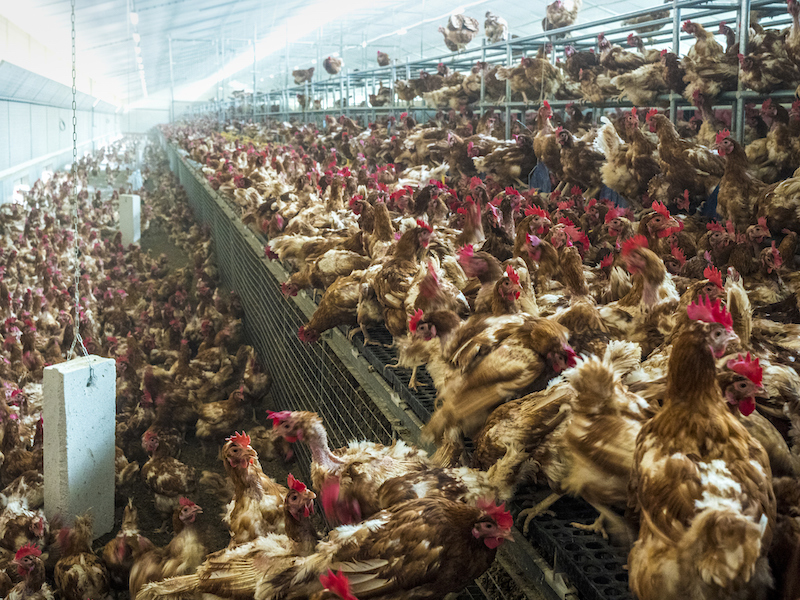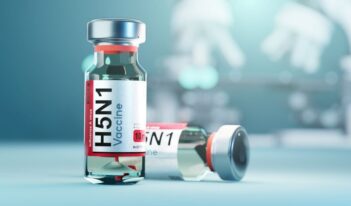
The CDC should recommend agricultural reforms to reduce pandemic risks caused by factory farms.
The U.S. public has many loves—car ownership, large sports events, and Fourth of July fireworks. But no love affair burns quite as hot as the public’s love for cheap, plentiful meat.
But could consuming large amounts of meat affect more than just your cholesterol levels?
Some scientists and activists have already warned that factory farming, which is the rearing of livestock under extreme confinement, emits dangerous amounts of greenhouse gases, abuses animals, and worsens nutritional diets and health. Despite these reasons for consumers to cut back on eating meat, the threat of another global pandemic could finally persuade U.S. consumers to reduce their meat consumption.
Changing meat-eating habits and encouraging stronger animal advocacy is difficult, but COVID-19 has forced more disruptive changes—such as altering work schedules, social habits, schooling, masking requirements, and more. To amass public support and spur agricultural change, the Centers for Disease Control and Prevention (CDC) should propose non-binding recommendations that encourage factory farms to limit extreme animal confinement, improve facility hygiene, cease antibiotic overuse, and reduce selective breeding practices.
Researchers have linked concentrated animal feeding operations (CAFOs) with increased viral and bacterial transmissions. Environmental stressors on CAFOs—such as animal overcrowding, enclosed facilities, illness-inducing grain feed, and unsanitary conditions—facilitate the spread of disease. These conditions also take a substantial toll on farm animals’ bodies and their ability to fight off infections.
In addition, CAFO operators administer large quantities of antibiotics to farm animals, increasing bacteria’s likelihood to mutate, develop antibiotic resistance, and pass to humans. Moreover, operators rear animals for profitable physical characteristics, such as breeding chickens to have large breasts. Breeding practices that produce genetically similar animals permit easier spread of infections because the animals lack the genetic variation needed to combat new viruses or bacteria.
Globalized markets add another layer of risk. International trade of farm animals and human travel redistributes pathogens and viral hosts, facilitating the exchange of genetic material between strains that otherwise would not have encountered each other.
Despite the global pandemic risk created by factory farming, the U.S. Department of Agriculture only has congressional authorization to regulate animal slaughtering, animal transportation, and animal product inspection, which all occurs after handlers have already removed animals from the CAFO facility.
Some agencies have attempted to reduce on-farm infection risks even without a specific law authorizing regulation of CAFO conditions. The U.S. Food and Drug Administration (FDA), for example, released nonbinding guidance to reduce animal ingestion of antibiotics that are critical to human health. Yet, factory farms have not drastically decreased antibiotics use and still pose a global pandemic risk.
Just as FDA attempted to redress factory farming pandemic risks through guidance, the CDC should release guidance recommending the elimination of extreme animal confinement and cleaner living and waste disposal standards. The CDC should also recommend ceasing antibiotics overuse and limiting selective breeding that produces genetically homogeneous animal populations. These recommendations would decrease the probability that novel viral or bacterial strains would survive and spread in factory farms, which decreases the probability that a human would become infected and spread illness to others in turn.
Although CAFO operators and managers would likely refuse to comply with such CDC guidance, the agency should not limit the guidance’s ambition because of anticipated noncompliance. Instead, the guidance should serve as a publicity tool to inform the public about the substantial and unjustifiable pandemic risks that factory farms impose on the United States and the entire globe.
And because the CDC has become a household name during the COVID-19 pandemic, it currently has the public’s attention and is in the best possible position to issue non-binding guidance about factory farms’ extraordinary pandemic risks.
Theoretically, the CDC could go a step further and issue binding regulations on factory farms to reduce pandemic risks. Under the Public Health Service Act, the CDC can issue regulations that are “necessary to prevent the introduction, transmission, or spread of communicable diseases,” that manifest in CAFOs.
But even if the CDC were to issue binding regulations, a court might invalidate them.
The U.S. Supreme Court has demonstrated that it will disregard an agency’s action if based on a legal interpretation that implicates major political or economic issues, even though courts in the past have usually deferred to agencies’ interpretations of ambiguous laws.
For example, the Supreme Court rejected the U.S. Environmental Protection Agency’s ability to regulate an energy transition from polluting plants toward less carbon-intensive energy generation under a certain section of the Clean Air Act. The Court determined that the Act’s section did not give the agency clear authority to “regulate a fundamental sector of the economy” and “force a nationwide transition” toward green energy.
Similarly, the Court would likely invalidate a CDC attempt to regulate the meat industry—for which the CDC lacks institutional expertise—because of the meat industry’s scale and profitability. The CDC might be able to regulate some less-consequential on-farm activities, such as requiring protective respirators for workers, but it is unlikely to dismantle the abusive practices that concern animal activists.
Furthermore, the Supreme Court and various district courts have clawed back the CDC’s regulatory power during the COVID-19 pandemic. The Supreme Court, for instance, held that the CDC’s second authorization of an eviction moratorium exceeded its legal authority, noting that the Public Health Service Act only explicitly authorizes inspections, fumigations, and other sanitary measures. Given the current trend, a CDC attempt to regulate factory farms as a pandemic threat would likely not survive judicial review.
But when binding legal approaches fail, rule makers can still facilitate change through nonbinding guidance. Despite no clear congressional authorization to regulate factory farm conditions, the CDC should issue guidance to illuminate the industry’s catastrophic pandemic risks. Then, consumers can determine whether they would rather uphold the meat industry as it currently exists or advocate agricultural changes to reduce risks of another life-altering global pandemic.



